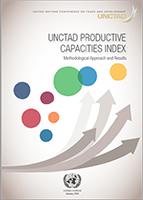
Measuring and benchmarking productive capacities globally reveals significant gaps, not only between developed and developing economies, but also among developing countries themselves. The new Productive Capacities Index (PCI) of UNCTAD demonstrates that differences in socioeconomic development across countries and regions are a consequence of gaps in their productive capacities. Structurally weak and vulnerable economies, including the least developed countries (LDCs) and landlocked developing countries (LLDCs) perform particularly poorly on PCI.
These persistent development challenges have been further compounded by novel external shocks and instability, including the coronavirus disease (COVID-19) pandemic, climate change effects, a collapse in global commodity prices and waning trust in multilateralism.
Building the economic resiliency of developing countries remains a daunting challenge. It depends fundamentally on creating, maintaining and using productive capacities to advance development. This will require a shift from the current fragmented and project-based interventions towards coherent, economy-wide and programme-based approaches to removing binding constraints on development. Actions and interventions at the domestic level need to be supported and complemented by additional robust international support.
PCI makes an important contribution to these efforts. The index draws on decades of extensive research and policy analysis work, as well as lessons learned from our technical support to the most vulnerable countries in developing key aspects of their trade and productive structures. The index is the first comprehensive attempt to measure productive capacities in all economies and construct a multidimensional index that can provide country-specific insights and diagnostics of productive capacity development. PCI also offers country and region-specific scores to help in understanding the sources of systemic vulnerabilities and identifying the enablers of economic growth, including progress towards national and global development targets.
This publication has been designed as a user-friendly and step-by-step guide to PCI. It walks the user through the methodological foundations of the index, aligned with the mandates given by the international community in the Programme of Action for the Least Developed Countries for the Decade 2011–2020 (Istanbul Programme of Action), the Vienna Programme of Action for Landlocked Developing Countries for the Decade 2014–2024 and the Nairobi Azimio and Nairobi Maafikiano, among others. It also provides a detailed overview of the index, its requisite categories and, importantly, the insights drawn from its results.
As part of its development, UNCTAD put the index through an extensive peer review process, including academic, statistical and technical reviews by experts. Member States tested and validated the index through a series of national workshops, policy-oriented discussions and technical exchanges with national staff. It is our belief that PCI can serve as an indispensable tool, to guide policy interventions and realign incentive structures to revive socioeconomic progress in a post-pandemic policy environment. Governments in all developing countries and their development partners are encouraged to closely examine and use the index for their specific needs. We believe it is both a powerful analytical and advocacy tool for putting productive capacity at the centre of international efforts to leave no one behind.
Secretary-General of UNCTAD
The UNCTAD Productive Capacities Index (PCI) is the outcome of United Nations Development Account Project 1617M, titled “Indices for benchmarking productive capacities for evidence-based policymaking in landlocked developing countries”.


